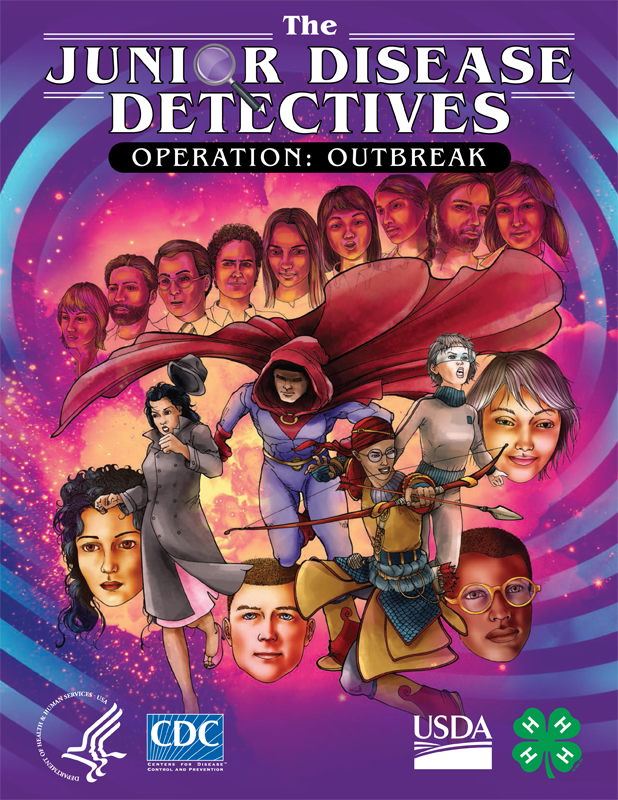CDC Releases Additional STEM Educational Activities for Teachers to use with the “Junior Disease Detectives: Operation Outbreak” Graphic Novel

The Junior Disease Detectives graphic novel and supplemental educational activities are available here.
August 28, 2019–Today, the Centers for Disease Control and Prevention (CDC) released additional STEM (i.e., science, technology, engineering and math) educational activities for middle and high school (grade 6-12) STEM teachers. This (version 2.0) web update adds two new classroom activities and includes updates to the existing classroom activities and teacher’s guide previously posted last August.
These educational materials are intended for teachers to use with the graphic novel published last August, entitled “The Junior Disease Detectives: Operation Outbreak.” The graphic novel educates youth audiences about CDC’s real life disease detective work and encourages them to consider STEM career options in public health and animal health. The graphic novel was originally created to educate youth about “variant influenza,” a term that refers to human infections with influenza (flu) viruses that normally circulate in swine (pigs).
The graphic novel follows group of teenage 4-H members who participate in a state agricultural fair and later attend the CDC Museum Disease Detective Camp in Atlanta. When Eddie, one of the teenagers, becomes sick following the fair, the rest of the group use their newly-acquired disease detective knowledge to help a team of public and animal health experts, including CDC’s Epidemic Intelligence Service (EIS) officers, solve the mystery of how their friend became sick. The graphic novel simulates an investigation of a case of variant influenza. As with most real-life variant influenza infections, Eddie’s character in the story is exposed to an infected pig and its environment at a large agricultural fair. Agricultural fair season in the United States typically begins during the summer and continues into the fall.
These activities were developed in collaboration with teachers participating in the CDC Science Ambassador Fellowship program. Activities target problem-based skill development, including collaborative performance, identifying trends, and decision-making, while presenting core concepts in epidemiology, public health, and other STEM disciplines. The activities also align with select national science standards for easy integration into the classroom.
Updates to the existing supplemental materials provide more comprehensive One Health information. A One Health approach requires human, animal and environmental health professionals to work together at the local, state, federal and global levels to improve the health of people, animals and their shared environment. The “Educational Overview” now includes important background information on key One Health concepts, in addition to an overview of flu viruses and how they can change, how flu spreads, and how zoonotic influenza viruses (i.e., flu viruses that spread between animals and people), like variant flu, are investigated. “Activity 1 – The Operation Outbreak Team” now also includes additional roles to demonstrate how professionals with diverse skills and expertise in public health, animal health, and environmental health work collaboratively to obtain, evaluate, and communicate information to solve disease outbreaks together.
The two new activities focus on disease classification and transmission. “Activity 3 – Eddie’s Story” challenges youth to make and revise data-driven decisions about disease as the scenario progresses. Like disease detectives, students use what they know about the main character, Eddie, and his illness to investigate a disease outbreak. As other people become ill (not portrayed in the graphic novel), students categorize their cases of disease by the “who, what, and when” (person, place, and time) and medical features (clinical signs and symptoms) of disease. Then, they use this case definition to decide if the other people’s illnesses are linked to Eddie’s. “Activity 3 – Hamlet’s Story” introduces students to disease modeling. Students explore and identify trends in the different ways flu viruses can spread between animals and people. Then, students create scenarios to explore the possible ways that Eddie could have become infected.
The graphic novel and its associated STEM educational content is available for free download from the CDC flu website at www.cdc.gov/flu/graphicnovel and the Apple iTunes store. Free print copies of the graphic novel are available via CDC’s On Demand website under Pub ID 300568. Note: Print orders larger than one copy are prioritized for K-12 teachers and 4-H groups and supplies are limited. The graphic novel was developed at CDC and illustrated by Bob Hobbs, the artist previously responsible for CDC’s Zombie Pandemic novella. It was developed in collaboration with the U.S. Department of Agriculture (USDA) and 4-H, the youth development organization affiliated with USDA. The graphic novel originally launched on Friday, August 10, as announced through a CDC press release.
No comments:
Post a Comment